About El trigal Ranch, Our Cattle, and Us
El trigal Ranch has the earliest and most unique recorded history of any Ranch in the United States of America.
In began in 1539 when Hernando de Soto, the first European to lead an expedition deep into interior of North America, approached the Aucilla River. The Aucilla River was the eastern boundary of the lands of the Apalachee Nation.
When Hernando de Soto and his men attempted to cross the Aucilla River they were met with great resistance from the Apalachee Natives, forcing them to cross this river in three separate locations.
One crossing was just south of US Hwy 27, the second crossing was on what would become El trigal Ranch, and the third crossing was south of El trigal Ranch. Once they entered what is now Jefferson County Florida, they continued westward to Anhaica, Tallahassee Florida, where they spent October 1539 to March of 1540. It was here Hernando de Soto, and his men celebrated the first Christmas in the United States of America.
One hundred later, in 1640, Florida Governor Ruiz de Salazar established a Hacienda 2.5 miles southeast of Lamont Florida on land controlled by the Apalachee Natives. It was on this Hacienda Governor Salazar introduced the Apalachee Natives to peaches, beans, wheat, watermelons, chickens, etc.
In 1645 Florida’s New Governor, Benito Ruiz de Salazar Vallacelli, expanded the previous Governors Hacienda to thepoint they were exporting wheat, processed beef, and other items to St Augustine and Cuba making the Governors Hacienda Americas first Commercial Cattle Ranch and Commercial Wheat Farm.
The direct descendants of Americas first Spanish Cattle are recognized today as Florida Cracker Cattle. The Spanish cattle that developed into the Texas Longhorn Cattle were not driven into Texas from Mexico until 1690.
The lands that formed the eastern boundary of the Florida Governors Hacienda, the west bank of the Aucilla River, are El tigal Ranch which includes the Cheyenne F. Floyd Land, the Susan K Floyd Homestead and the Pete Holland Land, the Bradley Cooley Estate, SRWMD Land, and the Mc Intosh land.
The central portion of the Governors Hacienda included the Bo Walker/Lanier Farm, the Starling Family Land, the Ganzy Family land, The Bill Jennings Farm, the Justin Forehand Farm, the Manual/Deal Farm, the Joey Collins Pine Plantation, a few small parcels on the east side of Old Salt Road, and other lands on the west side of Old Salt Road.
Numerous Spanish artifacts found on El trigal Ranch and the Bradley Cooley Estate document this was an advanced Spanish farming operation.
These Artifacts include Spanish axe heads, Spanish metal hoe’s, pottery, nails, hand forged hinges, pendants, beads, 54 brass bells, etc.




Numerous pieces of Spanish pottery sherds have been recovered on El trigal Ranch, the Bradley Cooley Estate, and the Finlayson property. Some of these pottery sherds are displayed on the following page.

My oldest Daughter, Mary Anne Folsom, owned 40 acres on the east side of the Aucilla River where the Apalachee Mound of Aisle is located. The town of Aisle is mentioned by the Scribes who wrote the daily narratives of Hernando de Sotos expedition as a Apalachee town they visited before crossing a river where they met great resistance.
According to the 1640’s Spanish records the Apalachee Natives from Aisle helped work the crops and livestock on the Governors Hacienda. The 40 acres of Aisle is presently owned by Tall Timbers and is being placed in a Conservation Easement to permanently protect the Mound. We will now review the El trigal Cattle Program.
Our objective for 34 years has been to produce the Healthiest Beef Possible for People who love beef but have concerns as to how Commercial Beef is being Produced and Processed.
To accomplish this, we stopped bringing mature cattle to El trigal, stopped vaccinating calves, using antibiotics, purchased future Herd Sires as yearlings, and AI ed some of our top cows to produce new herd sires. “{The most important factor in producing the healthiest Type Beef generation after generation is the Purity of the Parent Cattles’ genetics.}” The Texas Longhorn Cattle we use in our Beef Program are WR Branded cattle from the Wichita Wildlife Program, US branded cattle, Yates Cattle, and descendants from Marks cattle.

We will now review some of the Foundation cattle of the El trigal Ranch Texas Longhorn Herd. We will start with WR 762 in the picture on the following page grazing on El trigal Ranch. WR 762 had perfect Texas Longhorn conformation, the correct body weight of a Texas Longhorn cow 750 to 900 lbs. and displayed the largest set of triple twisted horns of any WR Branded Cow I know of.
WR 762 was purchased at a Wichita Wildlife Sale as a calf by a friend of mine, Don Basnett. I acquired WR 762 in a cow trade with Rick Bogle.
WR 762 on El trigal Ranch

Sunrise 762, below, is a daughter of WR 762

WR Branded Cattle are the descendants of the best Texas Longhorn Cattle that could be found in the 1930s. Agents working to save the Texas Longhorn Cattle from extension accumulated these cattle throughout the southwestern United States and Mexico. That project was funded by a $3000.00 US Government grant.
These cattle were inspected to eliminate the ones whose physical traits were outside the guidelines of a Texas Longhorn, as they were being gathered.
From that point the offspring of these cattle who, due to their recessive genes, displayed non-Texas Longhorn Features were removed from the Herd. Additional Texas Longhorn cattle were added to the WR Herd from private Ranchers such as the Yates and Marks Cattle. These Family’s had exceptional cattle and had kept them pure for generations.
Due to the continuing effort to remove cattle with non-Texas Longhorn traits and the accuracy of the WR records these cattle set the standard as to how true Texas Longhorn cattle should appear. At that time, they were the most sought-after Texas Longhorn Cattle and brought top prices.
Later, a second sanctuary for Texas Longhorn cattle was established by the government near Valentine Nebraska. These Texas Longhorn Cattle carried a US holding brand. These US cattle were selected from the best genetically and physically correct Texas Longhorn Cattle from the WR Herd and private herds of Texas Longhorn Cattle.
US 021, pictured on the following page, had the largest twisted horns of any US branded cow I know of and was one of the Best Producing Cows to carry the US Brand.
As you will see on the following pages, she passed her Triple Twisted Horns to all her daughters, granddaughters, and even to her Great Granddaughters.

I owned the US 021 son, US 8713, pictured below.

US 8713 weighed approximately 1600 pounds, his horns were narrow tip to tip, pointed forward, curled upward, had powerful front shoulders, and a strong neck for fighting. These features reflect how a Survival of the Fittest Bull had to be equipped to spread his genes. The genes that shaped his horns were also responsible for the twisted horns on Texas Longhorn Cows @ Steers you don’t see on most of the Modern Styled Longhorn Cattle.
I also owned a US 021 Daughter, US 471 Sadie, pictured below.

US 471 Sadie was also purchased by my friend, Don Blansitt, as a calf at a US sale.
US 8713, US 471 Sadie, WR 762, Wichita Gold, WR Bad George, 3 Yates Cows, and a few others are the foundation from which we formulated our El trigal Herd of Texas Longhorn Cattle.
Sadie Al below is a daughter of US Sadie 471

These types of Texas Longhorn Cattle are the ones that produce the Healthiest Beef represented on the 1987 Chart of Healthy Meats.
Sadie Al WR Specks below is a daughter of Sadie Al and WR Specks.
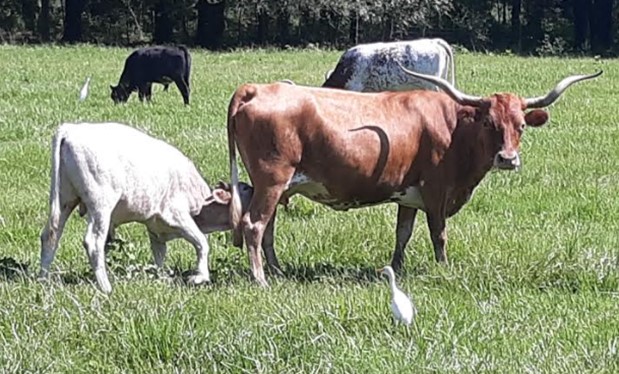
Sadie V below – is a daughter of US Sadie 471

Sadie Baby Gold below is a US 471 Sadie Daughter
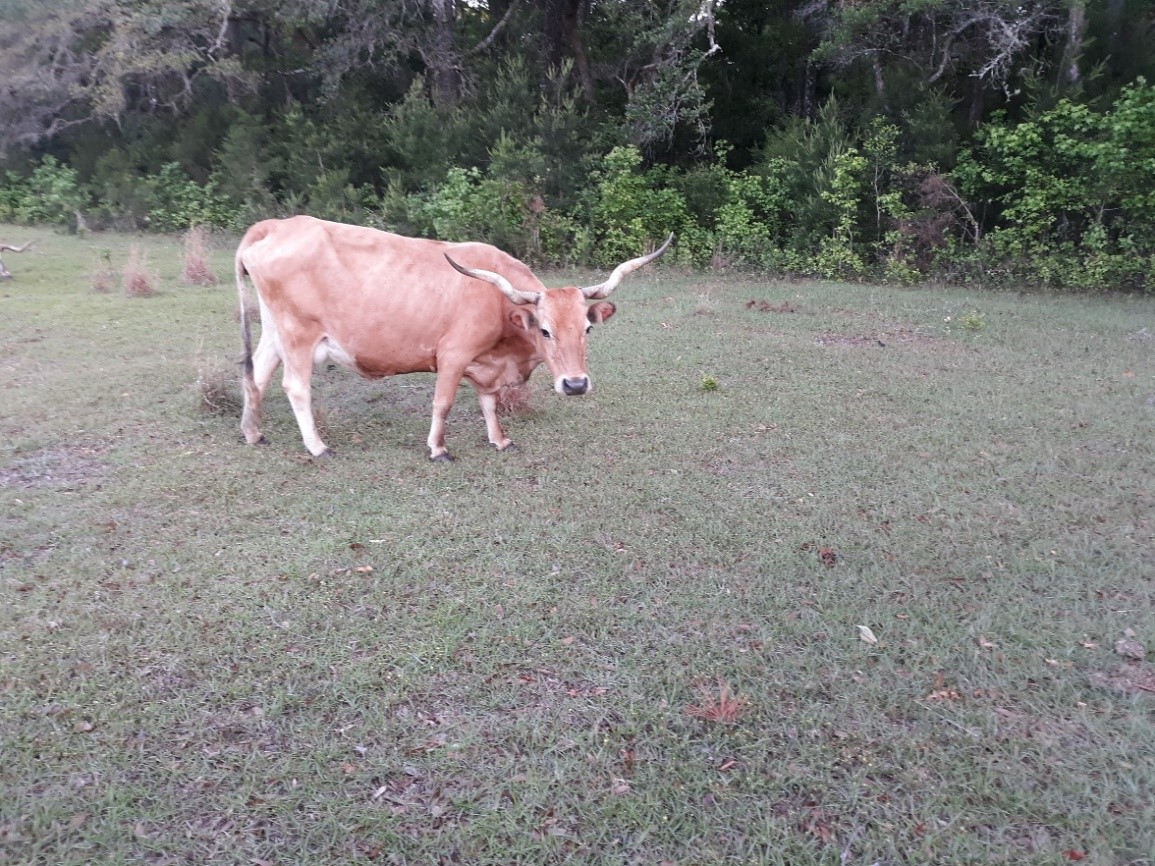
Sadie BG WR WT below is a Sadie Baby Gold Daughter

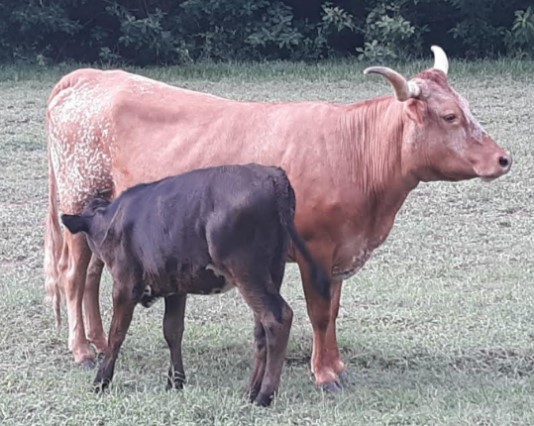
Pictured above is Sadie Baby Bold/Casper with her Wagyu Calf. I have 4 additional cows and heifers, not pictured, that are descendants of US 021. Each of these have corkscrew horns also.
I think US 021 was 16 years old when She was sold at a US Sale, indicating approximately 11 of her calves made positive contributions to other Texas Longhorn herds, since I only had 2 of her offspring.
Judging from my experience with Texas Longhorn Cattle, the contribution US 021 and WR 762 made on the El trigal Herd, positions them as two of the All-Time Greatest Texas Longhorn Cows to ever carry the WR and US Brands.
The two greatest producing cows I developed on El trigal Ranch were Gold 574 pictured below with WR 1850 and Sunrise 762 on the following page.
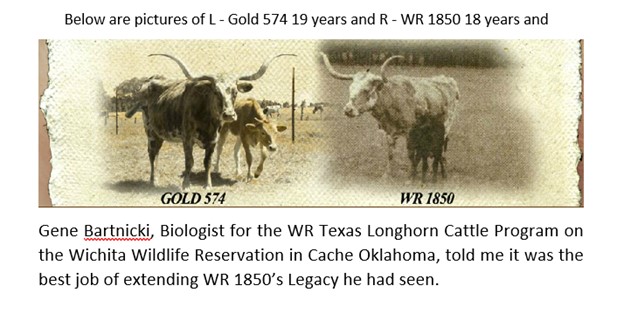

Sunrise 762 at age 11 years old
The photograph below is WR 762 Left Gold 574 Right at 20 years old.
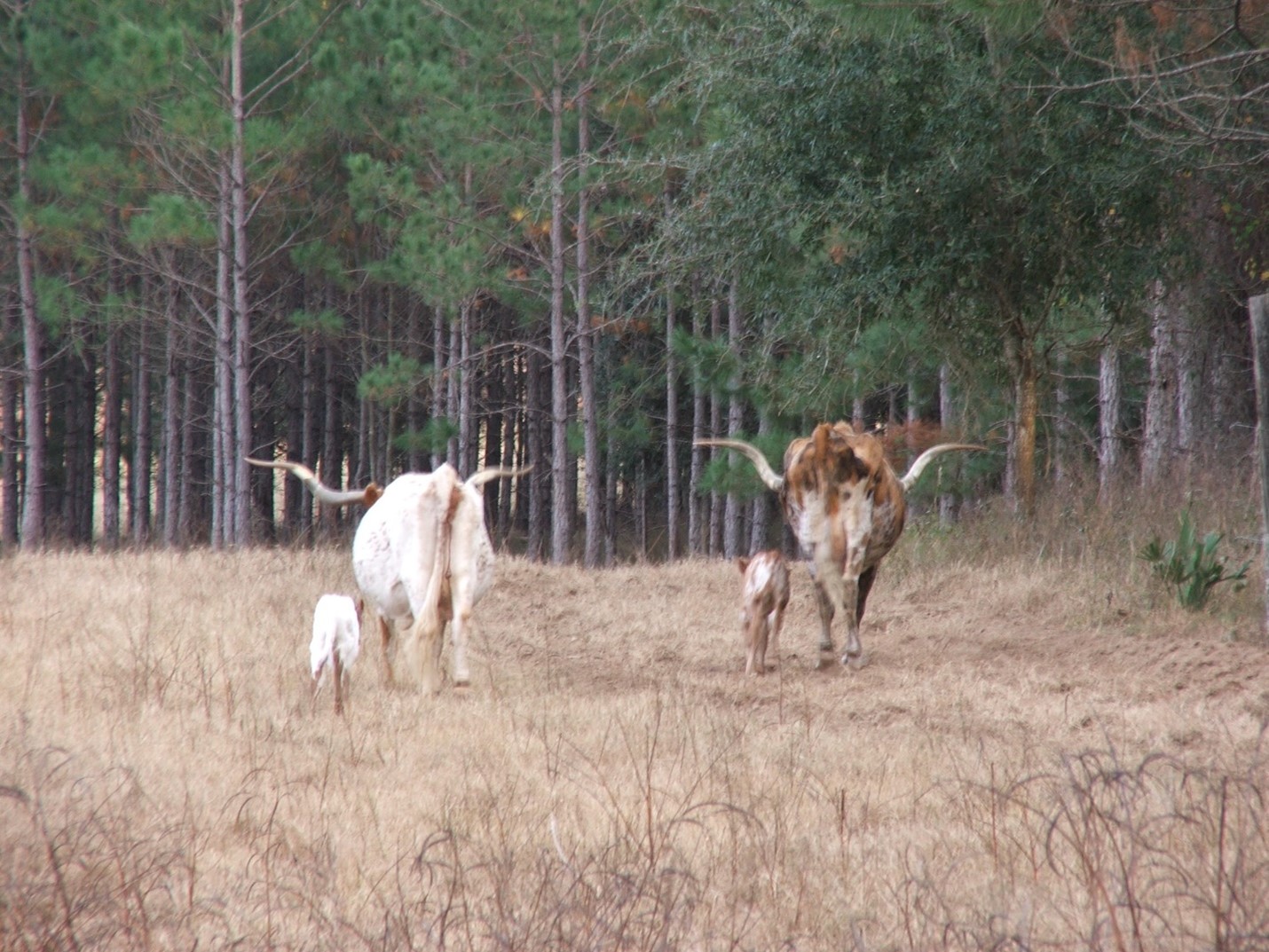
The questions to answer about today’s Texas Longhorn Beef are:
#1. What are the true genetics of the cattle that produced this Beef??
#2. What were the Conditions in which it was it produced?
#3. What did it eat? #4. What vaccines were given to this animal?
#5. Was it or its Ancestors given Growth Hormones?
Remember the #1 Healthiest Meat Test was conducted in 1987, before the mixing of Texas Longhorns with other cattle was obvious and being accepted in the Texas Longhorn Industry. In those early days people knew Texas Longhorn Bulls weighed from 1300 to 1600 pounds, cows weighed from 700 to 900 pounds, their correct body structure, and their correct horn style and size.
Today some of the bulls registered as Texas Longhorns weigh over 2200 lbs. with Tip-to Tip horn spans over 90 inches. These bulls could not survive in the rough conditions the Texas Longhorn cattle flourished in. You can view Modern Longhorn Cattle on the internet and determine if believe the Beef from their offspring will be as healthy as the beef of the genetically correct Texas Longhorn Cattle.
Beef from other breeds of cattle did not produce the healthy scores Texas Longhorn Beef produced in the 1987 test and they won’t today.
Approximately 330,000 Registered Texas Longhorn Cattle exist in America today, less than 60 herds of these cattle have qualified to be CTLR Registered.
The Cattlemen’s Texas Longhorn Registry is the only Texas Longhorn Registration Association I am aware of that requires a Visual Inspection and a DNA Test to register your cattle with them.
In the following pages we will review photographs of some of Americas original Texas Longhorn Cattle, Wichita Wildlife Refuge WR Branded Cattle, US Branded Longhorn Cattle from the Niobrara Refuge Herd in Valentine, Nebraska, Texas Longhorn Cattle at El trigal Ranch.
Once you have reviewed the information on our website you should look at the cattle that are being registered as Texas Longhorn Cattle today and decide for yourself which cattle You believe will produce the lean healthy beef represented in the 1987 test chart.
Next, we will review some of Alan Rogers early photographs of Texas Longhorn Cattle for you to compare to the Modern Longhorn Cattle on the internet and determine for yourself if Modern Texas Longhorn Cattle appear to be genetically correct Texas Longhorn Cattle.
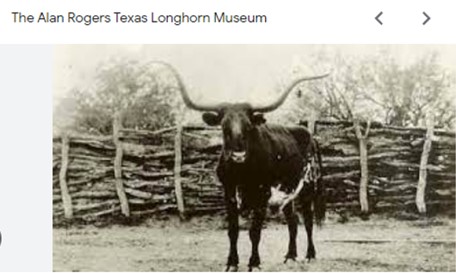
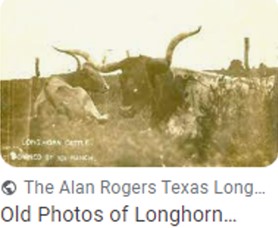
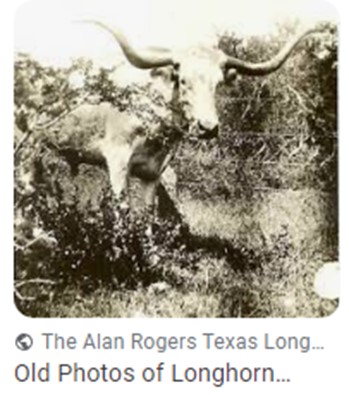
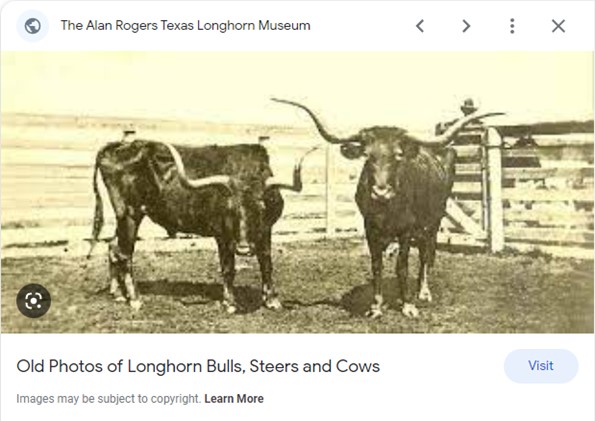
I witnessed a perfect example of how todays modern longhorns do not have the survival skills of the ones that developed in the wild. Tom Christensen and I Purchased US 8713. When US 8713 was delivered to Toms Farm and unloaded he and Toms wide horned Butler Bull, Marty, who was 300 pounds heavier than US 8713 began the battle for Dominance. Within a minute US 8713 had gashes up Marty’s sides and Tom was pancaked US 8713 was going to kill Marty. We got them separated and Tom immediately traded me his half interest in 8713.
This confirmed my opinion Modern Longhorn cattle have different genetics and have been developed under controlled conditions. This also means they do not produce the healthiest meat on the chart like the beef of the genetically correct Texas Longhorns.
When you view these modern longhorn bulls on the internet you now have the information You need to determine for Yourself if the Beef from their offspring will be equivalent to the lean and healthy beef of genetically correct Texas Longhorn Cattle.
Go back and “Check the Chart” regular ground beef and lean ground beef were two of the meats Texas Longhorn Beef out scored in all 4 catigories.
We will now look at the Wagyu Program we started on El trigal Ranch in July of 2021. Our first Wagyu calf was a heifer born on April 25th, Cheyenne’s birthday. Its Grand Dam was WR Co Co, the first WR branded cow Don Blansitt bought at a WR Sale. I gave this Heifer to Cheyenne as a birthday present. She will never leave El trigsl Ranch.
Crossing the Healthiest Lean Beef with heavy marveled Omega 3 and Omega 6 fat beef that is extremely tended and great tasting seemed like a good Combination for us to try on El trigal Ranch.
Today we have 74 American Wagyu Calves which range in age from a week old to 16 months old. American Wagyu Cattle should be 28 months old or older before they are processed. Our oldest Wagyu steers will be ready to process in 12 months.
1. Sixteen of these American Wagyu yearlings will average between 510 pounds and 530 pounds each.
2. Eighteen will average around 460 pounds each.
3. Fifteen will average 330 pounds each.
4. The smallest twenty-five Wagyu Calves will average around 130 pounds each.
Wagyu cattle and Texas Longhorn Cattle yield like Dairy Breeds of Cattle when Processed for beef.
The main difference being Texas Longhorn Beef is the healthiest of the 12 meats tested on the chart shown earlier. Wagyu Beef is the tenderest, best tasting, rarest, and most expensive beef in the world.
I recently talked to a friend of mine, Bubba Sullivan, who has been raising Texas Longhorn Wagyu cross cattle for over three years. Bubba told me everyone who has eaten this beef, without knowing what it was, said it was the best tasting tenderest beef they had ever eaten. The most important factor in producing the healthiest and best tasting beef generation after generation is the same in American Wagyu as it in all Cattle, the Purity of the Parent Cattle.
There are approximately 5,000 Full Blood Wagyu Cattle in the United States. I have two Full Blood Wagyu Bulls which is necessary to Produce true 50/50 American Wagyu Beef. We have one Florida Cracker Steer Processed and ready to be sold on this website. We have a Texas Longhorn Steer and a Texas Longhorn Angus cross Steer that will be processed in September.
We have a second Texas Longhorn Steer and an Angus Texas Longhorn cross steer ready to be process in October.
We have six more steers that will be ready in November, December, and January. Our goal is to process and sell 2 steers a month in the first half of 2024 and 3 steers a month in the second half of 2024. In June of 2024 we will process our first two American Wagyu Steers.
To Purchase Beef Call Bobby Floyd:
(850) 597-3751
Email wrbobbyfloyd@gmail.com
PO Box 2, Lamont, Florida, 32336
